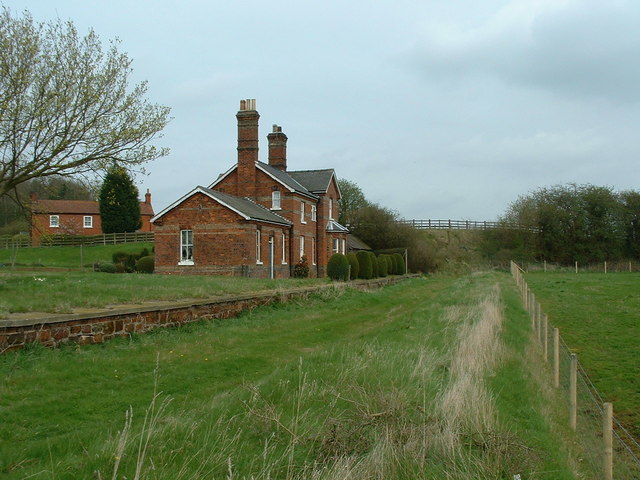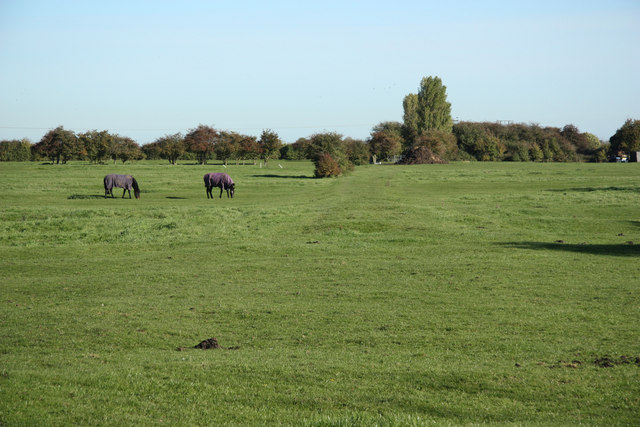|
Louth Railway Station
Louth railway station was a station in Louth, Lincolnshire, England. It served as a junction for several different now closed lines which converged on the town. The closure of the station has left Louth which has over 16,000 residents the largest town in Lincolnshire without a railway station. History The foundation stone of Louth railway station was formally laid on 8 July 1847 by Miss Charlotte Alington Pye, a popular ballad writer of the time (who used the pseudonym "Claribel" from a Tennyson poem). The architects of the station buildings were John Grey Weightman and Matthew Ellison Hadfield of Sheffield. The station was damaged by bombing on 19 February 1941 killing a local man, George Bradley, who was the fireman of an engine shunting in the goods yard. Louth Station was closed to passengers in 1970. The line northwards to Grimsby remained open for freight until 1980. A 5-car diesel multiple unit formed a special into Louth on 20 December 1980; at the time, the only re ... [...More Info...] [...Related Items...] OR: [Wikipedia] [Google] [Baidu] |
Louth, Lincolnshire
Louth () is a market town and civil parish in the East Lindsey district of Lincolnshire, England.OS Explorer map 283:Louth and Mablethorpe: (1:25 000): Louth serves as an important town for a large rural area of eastern Lincolnshire. Visitor attractions include St James' Church, Hubbard's Hills, the market, many independent retailers, and Lincolnshire's last remaining cattle market. Geography Louth is at the foot of the Lincolnshire Wolds where they meet the Lincolnshire Marsh. It developed where the ancient trackway along the Wolds, known as the Barton Street, crossed the River Lud. The town is east of a gorge carved into the Wolds that forms the Hubbard's Hills. This area was formed from a glacial overspill channel in the last glacial period. The River Lud meanders through the gorge before entering the town. To the direct south east of Louth is the village of Legbourne, to the north east is the village of Keddington, to the north west is the village of South Elking ... [...More Info...] [...Related Items...] OR: [Wikipedia] [Google] [Baidu] |
Legbourne Road Railway Station
Legbourne Road was a railway station on the East Lincolnshire Railway which served the village of Legbourne, Lincolnshire, Legbourne in Lincolnshire between 1848 and 1964. The station was closed to passengers in 1953, and withdrawal of goods facilities took place in 1964. The line through the station closed in 1970. The station once housed a museum containing railway memorabilia; this closed in 1998 and the building is once again a private residence. History The station was opened on 3 September 1848 as ''Legbourne'' after the village of Legbourne, Lincolnshire, Legbourne which lies to the east on what is now the A157 road, and renamed in May 1880 in an acknowledgement that there was some distance between the village and the station. It was constructed by Samuel Morton Peto, Peto and Edward Betts, Betts civil engineering General contractor, contractors who, in January 1848, had taken over the contract to construct the section of the East Lincolnshire Railway between and from J ... [...More Info...] [...Related Items...] OR: [Wikipedia] [Google] [Baidu] |
John Grey Weightman Railway Stations
John is a common English name and surname: * John (given name) * John (surname) John may also refer to: New Testament Works * Gospel of John, a title often shortened to John * First Epistle of John, often shortened to 1 John * Second Epistle of John, often shortened to 2 John * Third Epistle of John, often shortened to 3 John People * John the Baptist (died c. AD 30), regarded as a prophet and the forerunner of Jesus Christ * John the Apostle (lived c. AD 30), one of the twelve apostles of Jesus * John the Evangelist, assigned author of the Fourth Gospel, once identified with the Apostle * John of Patmos, also known as John the Divine or John the Revelator, the author of the Book of Revelation, once identified with the Apostle * John the Presbyter, a figure either identified with or distinguished from the Apostle, the Evangelist and John of Patmos Other people with the given name Religious figures * John, father of Andrew the Apostle and Saint Peter * Pope John ... [...More Info...] [...Related Items...] OR: [Wikipedia] [Google] [Baidu] |
Beeching Closures In England
Beeching is an English surname. Either a derivative of the old English ''bece'', ''bæce'' "stream", hence "dweller by the stream" or of the old English ''bece'' "beech-tree" hence "dweller by the beech tree".''Oxford Dictionary of English Surnames'', Reaney & Wilson, Oxford University Press 2005 People called Beeching include:- * Henry Charles Beeching (1859–1919) clergyman, author and poet * Jack Beeching (John Charles Stuart Beeching) (1922–2001), British poet * Richard Beeching (1913–1985), chairman of British Railways * Thomas Beeching (1900–1971), English soldier and cricketer * Vicky Beeching (Victoria Louise Beeching) (born 1979), British-born Christian singer See also * Beeching Axe The Beeching cuts (also Beeching Axe) was a plan to increase the efficiency of the nationalised railway system in Great Britain. The plan was outlined in two reports: ''The Reshaping of British Railways'' (1963) and ''The Development of the ..., informal name for th ... [...More Info...] [...Related Items...] OR: [Wikipedia] [Google] [Baidu] |
Railway Stations In Great Britain Closed In 1980
Rail transport (also known as train transport) is a means of transport that transfers passengers and goods on wheeled vehicles running on rails, which are incorporated in tracks. In contrast to road transport, where the vehicles run on a prepared flat surface, rail vehicles (rolling stock) are directionally guided by the tracks on which they run. Tracks usually consist of steel rails, installed on sleepers (ties) set in ballast, on which the rolling stock, usually fitted with metal wheels, moves. Other variations are also possible, such as "slab track", in which the rails are fastened to a concrete foundation resting on a prepared subsurface. Rolling stock in a rail transport system generally encounters lower frictional resistance than rubber-tyred road vehicles, so passenger and freight cars (carriages and wagons) can be coupled into longer trains. The operation is carried out by a railway company, providing transport between train stations or freight customer facil ... [...More Info...] [...Related Items...] OR: [Wikipedia] [Google] [Baidu] |
Railway Stations In Great Britain Opened In 1848
Rail transport (also known as train transport) is a means of transport that transfers passengers and goods on wheeled vehicles running on rails, which are incorporated in tracks. In contrast to road transport, where the vehicles run on a prepared flat surface, rail vehicles (rolling stock) are directionally guided by the tracks on which they run. Tracks usually consist of steel rails, installed on sleepers (ties) set in ballast, on which the rolling stock, usually fitted with metal wheels, moves. Other variations are also possible, such as "slab track", in which the rails are fastened to a concrete foundation resting on a prepared subsurface. Rolling stock in a rail transport system generally encounters lower frictional resistance than rubber-tyred road vehicles, so passenger and freight cars (carriages and wagons) can be coupled into longer trains. The operation is carried out by a railway company, providing transport between train stations or freight customer facilit ... [...More Info...] [...Related Items...] OR: [Wikipedia] [Google] [Baidu] |
Former Great Northern Railway Stations
A former is an object, such as a template, gauge or cutting die, which is used to form something such as a boat's hull. Typically, a former gives shape to a structure that may have complex curvature. A former may become an integral part of the finished structure, as in an aircraft fuselage, or it may be removable, being using in the construction process and then discarded or re-used. Aircraft formers Formers are used in the construction of aircraft fuselage, of which a typical fuselage has a series from the nose to the empennage, typically perpendicular to the longitudinal axis of the aircraft. The primary purpose of formers is to establish the shape of the fuselage and reduce the column length of stringers to prevent instability. Formers are typically attached to longerons, which support the skin of the aircraft. The "former-and-longeron" technique (also called stations and stringers) was adopted from boat construction, and was typical of light aircraft built until the ... [...More Info...] [...Related Items...] OR: [Wikipedia] [Google] [Baidu] |
Louth To Bardney Line
The Louth to Bardney Line was an English railway line built by the ''Louth and Lincoln Railway Company'', in Lincolnshire, England. It opened in stages between 1874 and 1876, after serious difficulties in raising subscription capital, and following alteration to the planned route. It was hoped to serve large reserves of ironstone along its route, but the deposits were not as large as hoped, and the line was never financially successful. The passenger service closed in 1951, and the residual goods service closed in stages from 1956 to 1960. Conception By 1866 the two main lines of the Great Northern Railway in Lincolnshire were well established: the original "Lincolnshire Loop" line via Lincoln, and the East Lincolnshire Line. The latter had been authorised by Parliament to the East Lincolnshire Railway company, but immediately leased to the GNR, which constructed it and operated it. In the 1860s thought was given to building a line from Louth to Lincoln and beyond, giving Grim ... [...More Info...] [...Related Items...] OR: [Wikipedia] [Google] [Baidu] |
Hallington Railway Station
Hallington railway station was a station in Hallington, Lincolnshire Lincolnshire (abbreviated Lincs.) is a county in the East Midlands of England, with a long coastline on the North Sea to the east. It borders Norfolk to the south-east, Cambridgeshire to the south, Rutland to the south-west, Leicestershire .... History The Great Northern Railway planned and built a branch line from to in stages, the final stage between and Louth opening to goods on 28 June 1876 and passengers on 1 December 1876. Hallington railway station was the first station west of Louth on this line. Passenger services ended on 5 November 1951, goods traffic on 17 December 1956. The station buildings still stand and are now a private dwelling. Route References {{Closed stations Lincolnshire Disused railway stations in Lincolnshire Former Great Northern Railway stations Railway stations in Great Britain opened in 1876 Railway stations in Great Britain closed in 1951 ... [...More Info...] [...Related Items...] OR: [Wikipedia] [Google] [Baidu] |
Mablethorpe Loop Railway
The Mablethorpe Loop railway was formed in Lincolnshire, England, by two independent railway companies, which built branches from the East Lincolnshire Line. The Louth and East Coast Railway opened its line, approaching Mablethorpe from the North, in 1877. This was followed by the opening of the Sutton and Willoughby Railway and Dock company in 1886; it had planned to create a large fishing dock at Sutton le Marsh, but it was unable to generate the capital to do so. Abandoning the dock idea, instead it built a connecting line to Mablethorpe, approaching from the south, and opening in 1888. Together the lines formed a loop off the main line. The two small companies sold their concerns to the Great Northern Railway in 1902 (S&WR) and 1908 (L&ECR). Mablethorpe developed very considerably as a holiday and excursion destination, facilitated by the railway connection, and the GNR did much to foster the business, running through excursions from Midlands towns, and later London, as w ... [...More Info...] [...Related Items...] OR: [Wikipedia] [Google] [Baidu] |
Grimoldby Railway Station
Grimoldy railway station was a station in Grimoldby, Lincolnshire; opened in 1877 by the Louth and East Coast Railway; and closed in 1960. References Disused railway stations in Lincolnshire Former Great Northern Railway stations Railway stations in Great Britain opened in 1877 Railway stations in Great Britain closed in 1960 {{Lincolnshire-railstation-stub ... [...More Info...] [...Related Items...] OR: [Wikipedia] [Google] [Baidu] |





